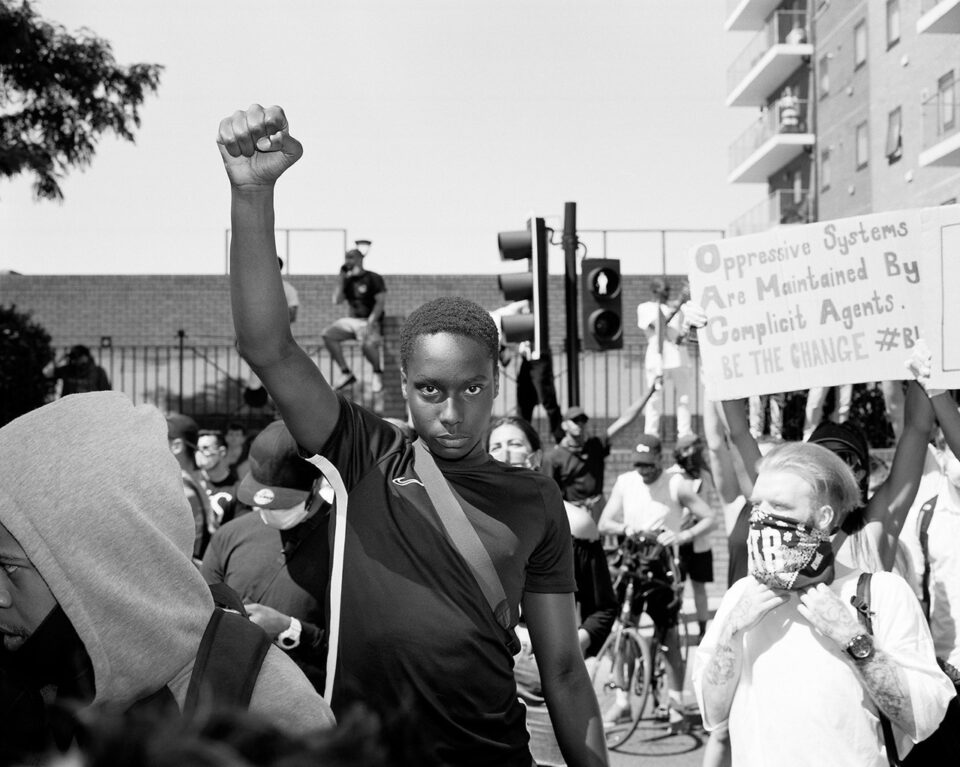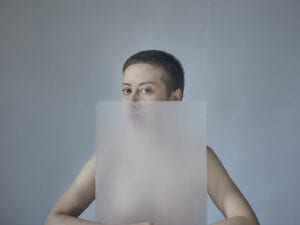In a photograph (possibly) taken by Claude Cahun in 1936, the artist Sheila Legge appears as a “Surrealist phantom” in Trafalgar Square, her head encased in flowers. Pigeons clamour along her outstretched arms. The wings of one bird are in rapid motion, blurring into a background that’s obscured by the photo’s shallow depth of field. Legge appears statuesque, and the world moves around her. The bouquet is a dark bloom, rendering her faceless and timeless. The image is arresting, but, as too often with Surrealist pictures, risks meaningless “what-about-if”-erry on one hand, and theoretical, Bourgeoise disconnectedness on the other.

Whether intentionally or not, the first photograph in Side Gallery’s Youth Rising in the UK, 1981-2021 (Paul Alexander Knox’s 2019 portrait of Michael, a young man from South Shields with a history of homelessness) recalls this picture of Legge. Michael’s head is entirely shrouded in a solid-seeming plume from his vape-pen. Traffic blurs like pigeons in the black-and-white surroundings. He’s anonymous, but extremely present. There’s no disappearing into clouds of theory, here. Knox’s photo, by covering Michael’s face, makes us take notice of him, remember him.
The exhibition follows the UK’s contemporary youth through trials of labour, alienation, and racial and social oppression, allowing human selves to emerge from hardship. The show explores what Cahun’s picture of Legge does not: that photographs make material the passing moments of history. These are not spaces for rarefied thought, but microzones in which people and time become tangible. Each of the nine photographers capture the lived reality of unprecedented times, whether it’s Tom Sussex’s portraits of Londoners involved in the Black Lives Matter protests, Chris Killip’s narrative of life and death in a remote fishing village, or Maryam Wahid using her mother’s traditional Pakistani wedding dress to explore 35 years of immigrant identity in Birmingham.

Sirkka-Liisa Konttinen’s images of intimacy on bleak and beautiful shores reassert her status as a documenter of human complexity almost in the league of Don McCullin. Alys Tomlinson’s portraits of sixth-formers dressed up for a prom they’ll never attend due to coronavirus are beautifully arranged, the light in the pictures appearing to emanate from the sitters themselves.
There’s a chance, here, of being a shade too saccharine, speaking in a register that’s a little “on-the-nose.” However, this is an occupational hazard of socially minded art, and, for the most part, Liz Hingley’s skilful curation swerves it (not least because the exhibition practices what it preaches by promoting student photographers from Sunderland and Bristol in a small bonus room).

One of Killip’s Skinningrove photos shows a queue outside a chip shop, an old woman leading two girls through the door, two cheeky boys in the window, one of them looking directly at us through two frames. Lines intersect beautifully, including the reflection of cables on a pylon at the top-right of the shop-front. And then you notice, on the glass, the mark left by someone wiping away condensation. As though clearing away the obfuscation of 20th century art photography, this photograph (and this exhibition) is an act of making visible, discovering the human, the un-surreal, in bizarre times. It acknowledges the contemporary screens which exist between us, but has faith that photos can ensure these screens are, at least, clear. We can see one another through them.
Side Gallery, Newcastle 17 July – 3 October
Words: Adam Heardman
Images:
1. Precious from the series Lost Summer, 2020) © Alys Tomlinson/HackelBury Fine Art
2. Emmaus Companion, Michael, 2019 © Paul Alexander Knox Commissioned by AmberSide and the Virgin Money Foundation
3. © Sirkka-Liisa Konttinen, courtesy AmberSide / L Parker Stephenson Photographs, NY
4. USA EMBASSY from the series Solidarity, May 2020 © Tommy Sussex





